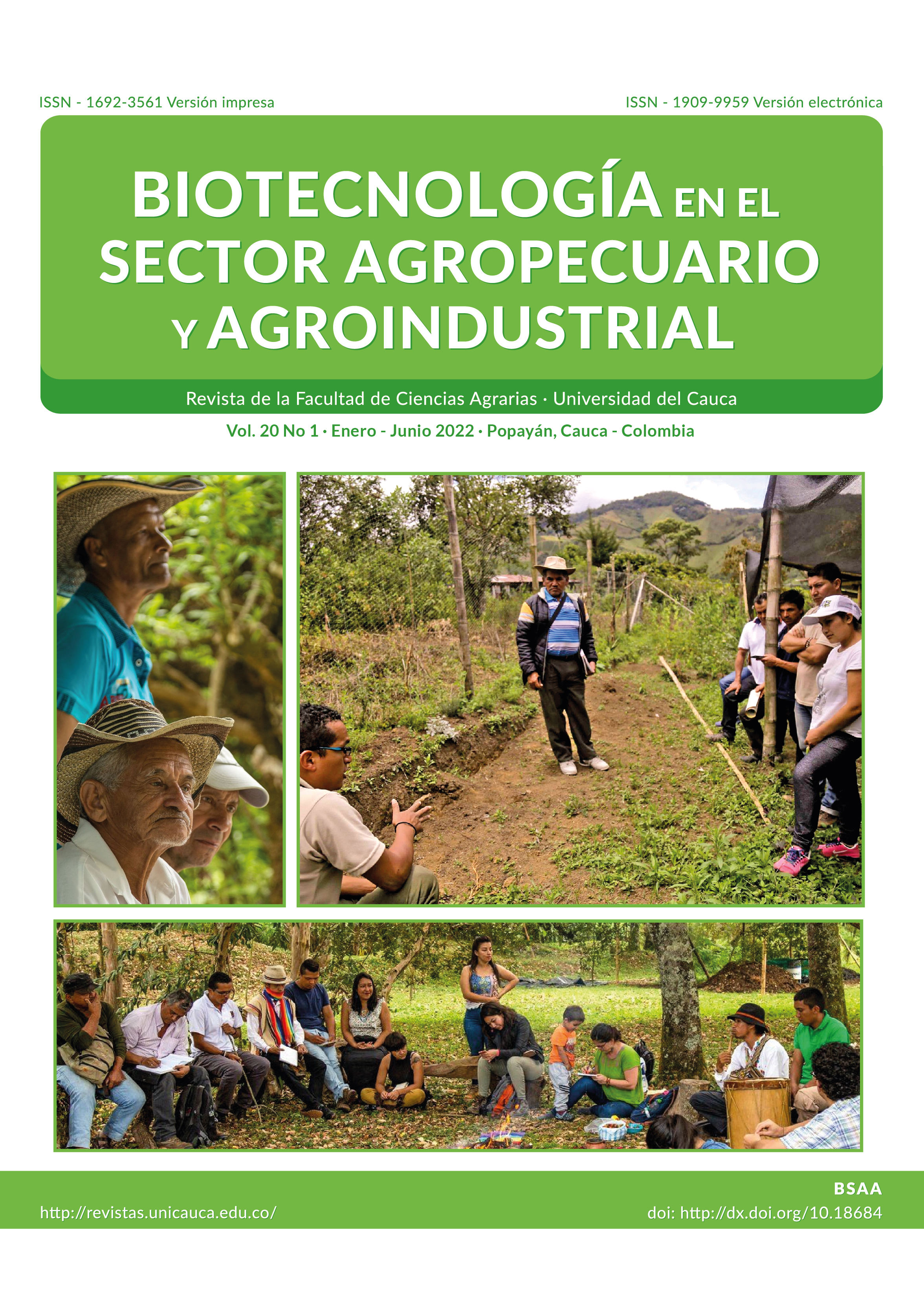Propóleos de Nariño: Propiedades fisicoquímicas y actividad biológica
Resumen
El propóleo, es un producto natural de consistencia resinosa y cauchosa elaborado por las abejas a partir de exudaciones de plantas. En este trabajo se caracterizaron las propiedades fisicoquímicas, atributos sensoriales y actividad biológica de extractos etanólicos de propóleo de tres diferentes zonas biogeográficas del departamento de Nariño. Muestras de propóleo crudo beneficiados de cada región fueron comparadas, y sus extractos alcohólicos fueron evaluados a través de métodos de separación y técnicas de espectroscopía. La actividad biológica fue evaluada usando cepas bacterianas de Staphylococcus aureus y Escherichia coli. Los análisis cromatográficos revelaron la presencia de metabolitos secundarios con actividad biológica frente a las bacterias estudiadas. Los espectros de infrarrojo y los cromatogramas, exhibieron diferencias entre las muestras, identificados como tipo -O y -B. La fracción fenólica, presentó diferencias significativas para flavonas y flavonoles. Los índices de oxidación fueron inferiores a 5 segundos. En relación a los extractos etanólicos evaluados, éstos mostraron una mayor sensibilidad sobre S. aureus en la técnica de Kirby-Bauer. La investigación realizada aporta al estudio y caracterización de propóleos de esta zona colombiana, ampliando el conocimiento sobre productos de origen natural.
Descargas
Disciplinas:
Química de productos naturales, Propiedades FisicoquímicasLenguajes:
Español; CastellanoReferencias bibliográficas
AHMED, R.; TANVIR, E.M.; HOSSEN, M.; AFROZ, R.; AHMMED, I.; RUMPA, N.E.; PAUL, S.; HUA-GAN, S.; SULAIMAN, S.; KHALIL, M. Antioxidant properties and cardioprotective mechanism of Malaysian propolis in rats. Evidence-Based Complementary and Alternative Medicine, n. 5370545, 2017, p. 1-11.https://doi:10.1155/2017/5370545
AL-ANI, I.; ZIMMERMANN, S.; REICHLING, J.; WINK, M. Antimicrobial Activities of European Propolis Collected from Various Geographic Origins Alone and in Combination with Antibiotics. Medicines, v. 5, n. 1, 2018, p. 2-17.https://doi:10.3390/medicines5010002
ANJUM, SI.; ULLAH, A.; KHAN, KA.; ATTAULLAH, M.; KHAN, H.; ALI, H.; BASHIR, M.; TAHIR, M.; ANSARI, M.; GHRAMH, H.; ADGABA, N.; DASH, C. Composition and functional properties of propolis (bee glue): A review. Saudi Journal of Biological Science, v. 26, n. 7, 2019, p. 1695-03.https://doi:10.1016/j.sjbs.2018.08.013
BABA, S.A.; MALIK, S.A. Determination of total phenolic and flavonoid content, antimicrobial and antioxidant activity of a root extract of Arisaema jacquemontii Blume. Journal of Taibah University for Science, v. 9, n. 4, 2015, p. 449-54.https://doi:10.1016/j.jtusci.2014.11.001
BARRERA, E.; GIL, J.; RESTREPO, A.; MOSQUERA, K.; DURANGO, D. A coating of chitosan and propolis extract for the postharvest treatment of papaya (Carica papaya L. cv. Hawaiiana). Revista Facultad Nacional de Agronomia Medellin, v. 68, n. 2, 2015, p. 7667-78. https://doi:10.15446/rfnam.v68n2.50982
BASTOS, E.M.; GUZMÁN, D.; FIGUEROA, J.; TELLO, J.; SCOARIS, D.O. Caracterización antimicrobiana y fisicoquímica de propóleos de Apis mellifera L. (Hymenoptera: Apidae) de la región andina colombiana. Acta Biológica Colombiana, v. 16, n. 1, 2011, p. 175-184.http://www.scielo.org.co/scielo.php?script=sci_arttext&pid=S0120-548X2011000100013
BETANCES-SALCEDO, E.; REVILLA, I.; VIVAR-QUINTANA, A.; GONZÁLEZ-MARTÍN, M. Flavonoid and Antioxidant Capacity of Propolis Prediction Using Near Infrared Spectroscopy. Sensors, v. 17, n. 7, 2017, p. 1647.https://doi:10.3390/s17071647
CIFTCI-YILMAZ, S.; AZMAN, Z.N.; KOSEM, K.; GUNDUZ, E.; GRENMAN, RG. Evaluating Antioxidant Capacity of Different Propolis Samples from Konya, Turkey and Their Inhibitory Effect on Head and Neck Cancer Cells. BioRxiv. n., 2017, 183913.https://doi:10.1101/183913
CUESTA-RUBIO, O.; PICCINELLI, A.L.; CAMPO-FERNÁNDEZ, M.; MÁRQUEZ-HERNÁNDEZ, I.; ROSADO, A., RASTRELLI, L. Chemical characterization of Cuban propolis by HPLC-PDA, HPLC-MS, and NMR: the brown, red, and yellow Cuban varieties of propolis. Journal Agricultural and Food Chemical, v. 55, 2007, p. 7502-09.https://doi:10.1021/jf071296w
CUPULL-SANTANA, R.D.; CORTÉS-RODRÍGUEZ, R.; OLAZÁBAL-MANSO, E.E.; HERNÁNDEZ-MEDINA, C.A. Actividad antifúngica de propóleos obtenidos en tres provincias de Cuba sobre hongos contaminantes en cultivos de tejidos vegetales. Acta Universitaria, v. 23, n. 6, 2013, p. 3-9.https://www.redalyc.org/articulo.oa?id=41629561001
DELGADO, A.M.L.; ANDRADE, O.J.; RAMÍREZ, B.C.A. Caracterización fisicoquímica de propóleos colectados en el Bosque La Primavera Zapopan, Jalisco. Revista Mexicana de Ciencias Forestales, v. 6, n. 28, 2015, p. 74-87. http://www.scielo.org.mx/scielo.php?script=sci_arttext&pid=S2007-11322015000200006
DRESCHER, N.; KLEIN, A.M.; NEUMANN, P.; YAÑEZ, O.; LEONHARDT, S. Inside honeybee hives: Impact of natural propolis on the ectoparasitic mite Varroa destructor and viruses. Insects, v. 8, n. 15, 2017, p. 1-18.https://doi:10.3390/insects8010015
EL-GUENDOUZ, S.; LYOUSSI, B.; MIGUEL, M. Insight on Propolis from Mediterranean Countries: Chemical Composition, Biological Activities and Application Fields. Chemistry & Biodiversity, v. 16, 2019, p. 1-35.https://doi:10.1002/cbdv.201900094
GUZELMERIC, E.; RISTIVOJEVIĆ, P.; TRIFKOVIĆ, J.; DASTAN, T.; YILMAZ, O.; CENGIZ, O.; YESILADA, E. Authentication of Turkish propolis through HPTLC fingerprints combined with multivariate analysis and palynological data and their comparative antioxidant activity. LWT - Food Science and Technology, v. 87, 2018, p. 23-32.https://doi:10.1016/j.lwt.2017.08.060
HERRERA, L.V.; PISCIOTTI, O.M.; RAMOS, M.O.; NEIRA, F.L.; SOTO, S.J. Actividad antimicrobiana in vitro de un propóleo de Santander sobre Enterococcus faecalis. Revista Ustasalud, v. 11, 2012, p. 73-78.https://doi:10.15332/us.v11i2.1119
HOCHHEIM, S.; GUEDES, A.; FACCIN-GALHARDI, L.; RECHENCHOSKI, D.Z.; NOZAWA, C.; LINHARES, R.E.; DA SILVA FILHO, H.; RAU, M.; SIEBERT, D.; MICKE, G.; MENDES DE CORDOVA, C. Determination of phenolic profile by HPLC–ESI-MS/MS, antioxidant activity, in vitro cytotoxicity and anti-herpetic activity of propolis from the Brazilian native bee Melipona quadrifasciata. Brazilian Journal of Pharmacognosy, v. 29, n. 3, 2019, p. 339-50.https://doi:10.1016/j.bjp.2018.12.010
KASIOTIS, K.M.; ANASTASIADOU, P.; PAPADOPOULOS, A.; MACHERA, K. Revisiting Greek propolis: chromatographic analysis and antioxidant activity study. PloS One, v. 12, n. 1, 2017, p. 1-27.https://doi:10.1371/journal.pone.0170077
LÓPEZ, B.G.C.; SCHMIDT, E.M.; EBERLIN, M.N.; SAWAYA, A.C.H.F. Phytochemical markers of different types of red propolis. Food Chemistry, v. 146, 2014, p. 174–180. https://doi:10.1016/j.foodchem.2013.09.063
MARTÍNEZ, J.; GARCÍA, C.; DURANGO, D.; GIL, J. Caracterización de propóleos provenientes del municipio de Caldas obtenido por dos métodos de recolección. Revista MVZ Córdoba, v. 17, n. 1, 2012, p. 2861-69.https://doi:10.21897/rmvz.254
MEILGAARD, M.; CIVILLE, G.V.; CARR, B.T. Sensory Evaluation Techniques. 4th ed. Boca Raton (USA): CRC Press; 2015.https://books.google.com.co/bookshl=es&lr=&id=lGjdCgAAQBAJ&oi=fnd&pg=PP1&dq=Sensory+Evaluation+Techniques.+4th+ed.&ots=FSCgXBCDU9&sig=XVIpG4_vVbG0c0ma8MAOeZ9QVeY#v=onepage&q=Sensory%20Evaluation%20Techniques.%204th%20ed.&f=false
MIYATAKA, H.; NISHIKI, M.; MATSUMOTO, H.; FUJIMOTO, T.; MATSUKA, M.; SATOH, T. Evaluation of Propolis. I. Evaluation of Brazilian and Chinese Propolis by Enzymatic and Physico-Chemical Methods. Biological and Pharmaceutical Bulletin, v. 20, n. 5, 1997, p. 496-501.https://doi:10.1248/bpb.20.496
OLIVEIRA, R.N.; MANCINI, M.C.; DE OLIVEIRA, F.C.S.; PASSOS, T.M.; QUILTY, B.; DA THIRÉ, R.M.; Mc GUINNESS. FTIR analysis and quantification of phenols and flavonoids of five commercially available plants extracts used in wound healing. Matéria (Rio J), v. 21, n. 3, 2016, p. 767-79.https://doi:10.1590/S1517-707620160003.0072
OMAR, R.; IGOLI, J.O.; ZHANG, T.; GRAY, A.I.; EBILOMA, G.U.; CLEMENTS, C.J.; FEARNLEY, J.; EBEL, R.; PAGET, T.; DE KONING, H.; WATSON, D. The chemical characterization of Nigerian propolis samples and their activity against Trypanosoma brucei. Scientific Report, v. 7, n. 923, 2017, p. 1-10.https://doi:10.1038/s41598-017-01038-2
OSORIO, T.M.; SALAMANCA, G.G. Actividad biológica del propóleo. En Origen, naturaleza, propiedades fisicoquímicas y valor terapéutico del propóleo. 1 ed. Ibagué (Colombia): Sello editorial de la Universidad del Tolima, 2017. p. 287-323.https://www.researchgate.net/publication/328346989_Origen_naturaleza_propiedades_fisicoquimicas_y_valor_terapeutico_del_propoleo
PALOMINO, L.; MARTÍNEZ, J.; GARCÍA, C.; GIL, J.; DURANGO, D. Caracterización Fisicoquímica y Actividad Antimicrobiana del Propóleos en el Municipio de La Unión (Antioquia, Colombia). Revista Facultad Nacional de Agronomía Medellín, v. 63, 2010, p. 5373-83.http://www.scielo.org.co/pdf/rfnam/v63n1/a13v63n01.pdf
PRZYBYŁEK, I.; KARPIŃSKI, T.M. Antibacterial Properties of Propolis. Molecules, v. 24, n. 2047, 2019, p. 1-17.https://doi:10.3390/molecules24112047
RODRÍGUEZ, Y.; SÁNCHEZ-CATALÁN, F.; ROJANO, B.; DURANGO, D.; GIL, J.; MARÍN-LOAIZA, J. Caracterización fisicoquímica y evaluación de la actividad antioxidante de propóleos recolectados en el departamento del Atlántico, Colombia. Revista UDCA Actualidad & Divulgación Científica, v. 15, n. 2, 2012, p. 303-311.http://www.scielo.org.co/scielo.php?pid=S0123-42262012000200007&script=sci_abstract&tlng=es
SALAMANCA, G.G.; OSORIO, T.M. New insular red propolis from Colombia: botanical origin, biological and chemical markers. En: 30th International Symposium on the Chemistry of Natural Products and the 10th International Congress On Biodiversity. Atenas (Grecia):2018.https://cdn.technologynetworks.com/ep/pdfs/new-insular-red-propolis-from-colombia-botanical-origin-biological-and-chemical-markers.pdf
SALAMANCA, G.G.; RAMÍREZ, C.; RUBIANO, L. Contenido mineral de los propóleos colectados en algunas zonas biogeográficas colombianas. Revista Institucional Universidad Tecnológica del Chocó, v. 20, n. 1, 2004, p. 79-85.
SALAMANCA, G.G. Origen, naturaleza, propiedades fisicoquímicas y valor terapéutico del propóleo. 1 ed. Ibagué (Colombia): Sello editorial Universidad del Tolima, 2017.
SAWAYA, A.C.H.F.; BARBOSA-DA SILVA-CUNHA, I.; MARCUCCI, M.C. Analytical methods applied to diverse types of Brazilian propolis. Chemistry Central Journal, v. 5, n. 27, 2011, p. 1-10.https://www.ncbi.nlm.nih.gov/pmc/articles/PMC3123264/pdf/1752-153X-5-27.pdf
SEIBERT, J.B.; BAUTISTA-SILVA, J.P.; AMPARO, T.R.; PETIT, A.; PERVIER, P.; DOS SANTOS ALMEIDA, J.C.; AZEVEDO, M.; SILVEIRA, B.; BRANDÃO, G.; DE SOUZA, G.; TEIXEIRA, L.; DOS SANTOS, O. Development of propolis nanoemulsion with antioxidant and antimicrobial activity for use as a potential natural preservative. Food Chemistry, v. 287, 2019, p. 61-67. https://doi:10.1016/j.foodchem.2019.02.078
SELVARAJ, R.; SIVAKUMARI, K.; FLORA-PRIYADARSHINI, J.; ASHOK, K.; JAYAPRAKASH, P.; RAJESH, S. Phytochemical profiling and antibacterial activity of propolis. International Journal of Scientific Research, v. 7, n. 6, 2018, p. 373-376.https://www.researchgate.net/publication/330170066_PHYTOCHEMICAL_PROFILING_AND_ANTIBACTERIAL_ACTIVITY_OF_PROPOLIS
SFORCIN, J.M. Biological properties and therapeutic applications of propolis. Phytotheraphy Research, v. 30, 2016, p. 894–905.https://doi:10.1002/ptr.5605
SHAWKY, E.; IBRAHIM, R.S. Bioprofiling for the quality control of Egyptian propolis using an integrated NIR-HPTLC-image analysis strategy. Journal of Chromatography B: Biomedical and Applications, v. 1095, 2018, p. 75–86.https://doi:10.1016/j.jchromb.2018.07.029
TALERO, C.; HERNÁNDEZ, D.; FIGUEROA, J. Calidad microbiológica de propóleo crudo y sólidos solubles de extractos de propóleo de Apis mellifera en Colombia. Revista Medicina Veterinaria y Zootecnia, v. 59, n. 2, 2012, p. 109-118.http://www.scielo.org.co/scielo.php?pid=S0120-29522012000200005&script=sci_abstract&tlng=es
TOUZANI, S.; EMBASLAT, W.; IMTARA, H.; KMAIL, A.; KADAN, S.; ZAID, H.; ELARABI, I.; BADIAA, L.; SAAD, B. In vitro evaluation of the potential use of propolis as a multitarget therapeutic product: Physicochemical properties, chemical composition, and inmmunomodulatory, antibacterial, and anticancer properties. BioMed Research International, v. 2019, 2019, p. 1-11.https://doi.org/10.1155/2019/4836378
VEIGA, R.S.; DE MENDONÇA, S.; MENDES, P.B.; PAULINO, N.; MIMICA, M.J.; LAGAREIRO NETTO, A.A.; LIRA, I.S.; LOPEZ, B.G.; NEGRÃO, V.; MARCUCCI, M.C. Artepillin C and phenolic compounds responsible for antimicrobial and antioxidant activity of green propolis and Baccharis dracunculifolia DC. Journal of Applied Microbiology, v. 122, n. 4, 2017, p. 911-20.https://doi:10.1111/jam.13400
VELASQUEZ, B.D.; MONTENEGRO, S.P. Actividad antimicrobiana de extractos etanólicos de propóleos obtenidos de Apis mellifera. Revista de Investigación Agraria y Ambiental, v. 8, n. 1, 2017, p. 185-93.https://doi:10.22490/21456453.1848
VELOZ, J.J.; ALVEAR, M.; SALAZAR, L.A. Antimicrobial and antibiofilm activity against Streptococcus mutans of individual and mixtures of the main polyphenolic compounds found in Chilean propolis. BioMed Research International, v. 7602343, 2019, p. 1-7. https://doi:10.1155/2019/7602343
VILORIA, J.; GIL, J.; DURANGO, D.; GARCÍA, C. Caracterización fisicoquímica del propóleo de la Región del Bajo Cauca Antioqueño (Antioquia, Colombia). Biotecnología en el Sector Agropecuario y Agroindustrial, v. 10, 2012, p. 76-85. http://www.scielo.org.co/scielo.php?pid=S1692-35612012000100010&script=sci_abstract&tlng=es
ZAINULLIN, R.A.; KUNAKOVA, R.V.; GAREEV, V.F.; GALYAUTDINOV, I.V.; SADRETDINOVA, Z.R.; MUSLIMOV, Z.S.; ODINOKIV, N. Flavanones and flavones from ashkir propolis. Chemistry of Natural Compounds, v. 54, n. 5, 2018, p. 975-77.https://doi:10.1007/s10600-018-2526-5


 Español
Español Inglés
Inglés





















.png)



